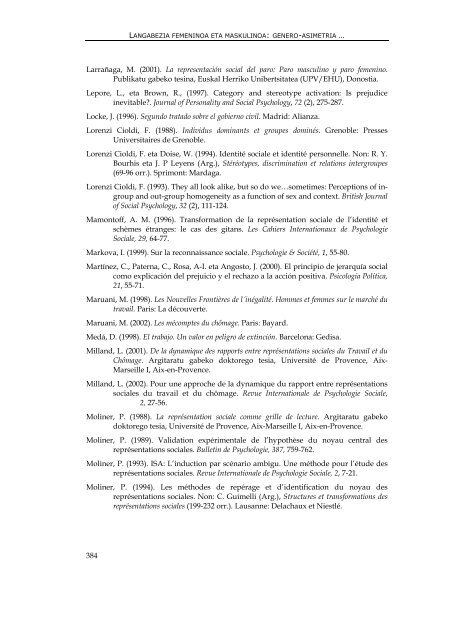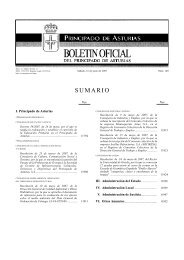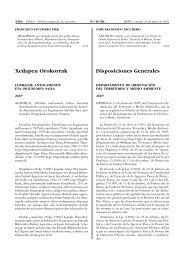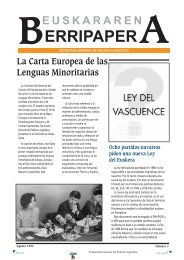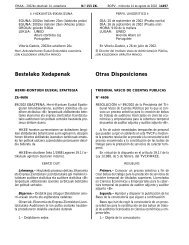- Page 1 and 2:
Jakintza-arloa: Psikologia Langabez
- Page 3:
Gizarte Psikologia eta Portaera Zie
- Page 6 and 7:
LANGABEZIA FEMENINOA ETA MASKULINOA
- Page 8 and 9:
d LANGABEZIA FEMENINOA ETA MASKULIN
- Page 10 and 11:
f LANGABEZIA FEMENINOA ETA MASKULIN
- Page 12 and 13:
h LANGABEZIA FEMENINOA ETA MASKULIN
- Page 14 and 15:
j LANGABEZIA FEMENINOA ETA MASKULIN
- Page 17 and 18:
Taulen aurkibidea 1.Taula: Aix-en-P
- Page 19 and 20:
AURKIBIDEA 38. Taula: Aix-en-Proven
- Page 21:
AURKIBIDEA Grafikoen aurkibidea 1.
- Page 24 and 25:
2 LANGABEZIA FEMENINOA ETA MASKULIN
- Page 26 and 27:
4 LANGABEZIA FEMENINOA ETA MASKULIN
- Page 28 and 29:
6 LANGABEZIA FEMENINOA ETA MASKULIN
- Page 31 and 32:
I. HURBILPEN TEORIKOA 1. Sarrera In
- Page 33 and 34:
HURBILPEN TEORIKOA 2.1. ERAGIN TEOR
- Page 35 and 36:
HURBILPEN TEORIKOA Moscovici-k, ber
- Page 37 and 38:
HURBILPEN TEORIKOA sozialari helduz
- Page 39 and 40:
HURBILPEN TEORIKOA valeurs correspo
- Page 41 and 42:
HURBILPEN TEORIKOA esker errealitat
- Page 43 and 44:
HURBILPEN TEORIKOA langabeziaren ir
- Page 45 and 46:
HURBILPEN TEORIKOA Objektu sozial b
- Page 47 and 48:
HURBILPEN TEORIKOA zuzen ere (Abric
- Page 49 and 50:
HURBILPEN TEORIKOA • Egoera baten
- Page 51 and 52:
HURBILPEN TEORIKOA aldetik, praktik
- Page 53 and 54:
HURBILPEN TEORIKOA dagoenaren ideia
- Page 55 and 56:
HURBILPEN TEORIKOA Sortutako baldin
- Page 57 and 58:
HURBILPEN TEORIKOA Irudikapenarekin
- Page 59 and 60:
HURBILPEN TEORIKOA Bestalde, objekt
- Page 61 and 62:
HURBILPEN TEORIKOA 3.2.1. Sistema a
- Page 63 and 64:
HURBILPEN TEORIKOA arteko bereizket
- Page 65 and 66:
HURBILPEN TEORIKOA langabeziarekiko
- Page 67 and 68:
HURBILPEN TEORIKOA universelle que
- Page 69:
HURBILPEN TEORIKOA papera aztertzea
- Page 73 and 74:
II. TEORIATIK IKERKETA OBJEKTURA 1.
- Page 75 and 76:
TEORIATIK IKERKETA OBJEKTURA Gizart
- Page 77 and 78:
TEORIATIK IKERKETA OBJEKTURA Hiriak
- Page 79 and 80:
TEORIATIK IKERKETA OBJEKTURA Indust
- Page 81 and 82:
TEORIATIK IKERKETA OBJEKTURA instru
- Page 83 and 84:
TEORIATIK IKERKETA OBJEKTURA sturdy
- Page 85 and 86:
TEORIATIK IKERKETA OBJEKTURA modèl
- Page 87 and 88:
TEORIATIK IKERKETA OBJEKTURA Nazioa
- Page 89 and 90:
TEORIATIK IKERKETA OBJEKTURA eta so
- Page 91 and 92:
TEORIATIK IKERKETA OBJEKTURA garape
- Page 93 and 94:
TEORIATIK IKERKETA OBJEKTURA Genero
- Page 95:
TEORIATIK IKERKETA OBJEKTURA Sistem
- Page 99 and 100:
III. HURBILPEN METODOLOGIKOA 1. Sar
- Page 101 and 102:
HURBILPEN METODOLOGIKOA 2.1. GOGORA
- Page 103 and 104:
HURBILPEN METODOLOGIKOA 2.1.2. Datu
- Page 105 and 106:
HURBILPEN METODOLOGIKOA 1. Irudia:
- Page 107 and 108:
HURBILPEN METODOLOGIKOA puntuazioa
- Page 109 and 110:
2.2.2. Datuen azterketa HURBILPEN M
- Page 111 and 112:
HURBILPEN METODOLOGIKOA Estimulu ez
- Page 113 and 114:
HURBILPEN METODOLOGIKOA sistema ara
- Page 115 and 116:
HURBILPEN METODOLOGIKOA 2.4.1. Tekn
- Page 117 and 118:
HURBILPEN METODOLOGIKOA bat egitea
- Page 119 and 120:
HURBILPEN METODOLOGIKOA Aix-en-Prov
- Page 121 and 122:
HURBILPEN METODOLOGIKOA aztora ditz
- Page 123 and 124:
HURBILPEN METODOLOGIKOA XXX jaunak
- Page 125:
HURBILPEN METODOLOGIKOA errefusapen
- Page 129 and 130:
IV. IKERKETAREN EMAITZAK 1. Sarrera
- Page 131 and 132:
IKERKETAREN EMAITZAK inguruan emand
- Page 133 and 134:
IKERKETAREN EMAITZAK 4. Gabezia dim
- Page 135 and 136:
Maiztasuna = 3,1 Argent Diplôme En
- Page 137 and 138:
IKERKETAREN EMAITZAK lana eta enple
- Page 139 and 140:
IKERKETAREN EMAITZAK (“rechercher
- Page 141 and 142:
IKERKETAREN EMAITZAK - Galderen ord
- Page 143 and 144:
IKERKETAREN EMAITZAK duten bitartea
- Page 145 and 146:
Maiztasuna = 3,1 Aides Allocations
- Page 147 and 148:
IKERKETAREN EMAITZAK - Gabezia adie
- Page 149 and 150:
IKERKETAREN EMAITZAK egiten da (“
- Page 151 and 152:
Erdigunea IKERKETAREN EMAITZAK Gune
- Page 153 and 154:
IKERKETAREN EMAITZAK - Alderdi sozi
- Page 155 and 156:
IKERKETAREN EMAITZAK eta 121emakume
- Page 157 and 158:
IKERKETAREN EMAITZAK Dimentsio haue
- Page 159 and 160:
Erdigunea IKERKETAREN EMAITZAK Gune
- Page 161 and 162:
dago. IKERKETAREN EMAITZAK “deses
- Page 163 and 164:
IKERKETAREN EMAITZAK 7. Alderdi soz
- Page 165 and 166:
IKERKETAREN EMAITZAK kasuan alderdi
- Page 167 and 168:
IKERKETAREN EMAITZAK Honakoak dira
- Page 169 and 170:
IKERKETAREN EMAITZAK CATINI program
- Page 171 and 172:
IKERKETAREN EMAITZAK CATINI program
- Page 173 and 174:
IKERKETAREN EMAITZAK 2. Grafikoa: A
- Page 175 and 176:
IKERKETAREN EMAITZAK CATINI program
- Page 177 and 178:
Langabezia femeninoa IKERKETAREN EM
- Page 179 and 180:
IKERKETAREN EMAITZAK dimentsio haue
- Page 181 and 182:
IKERKETAREN EMAITZAK 2. 3. 2. Baion
- Page 183 and 184:
IKERKETAREN EMAITZAK Kategorien art
- Page 185 and 186:
IKERKETAREN EMAITZAK Langabezia mas
- Page 187 and 188:
IKERKETAREN EMAITZAK 17,4a barnerat
- Page 189 and 190:
Langabezia femeninoa IKERKETAREN EM
- Page 191 and 192:
IKERKETAREN EMAITZAK dituztenak, be
- Page 193 and 194:
2. 3. 3. Irungo datuak IKERKETAREN
- Page 195 and 196:
IKERKETAREN EMAITZAK dituztenak, be
- Page 197 and 198:
IKERKETAREN EMAITZAK STATCAT progra
- Page 199 and 200:
IKERKETAREN EMAITZAK mantentzen du
- Page 201 and 202:
IKERKETAREN EMAITZAK CATINI program
- Page 203 and 204:
IKERKETAREN EMAITZAK 18. Grafikoa:
- Page 205 and 206:
IKERKETAREN EMAITZAK 3. KARAKTERIZA
- Page 207 and 208:
IKERKETAREN EMAITZAK azterketarako,
- Page 209 and 210:
Itemak Batez bestekoa IKERKETAREN E
- Page 211 and 212:
IKERKETAREN EMAITZAK ditzake” ite
- Page 213 and 214:
IKERKETAREN EMAITZAK 3.2.2. Errefer
- Page 215 and 216:
Itemak Batez bestekoa IKERKETAREN E
- Page 217 and 218:
IKERKETAREN EMAITZAK Ugazaba baten
- Page 219 and 220:
IKERKETAREN EMAITZAK banaketa bat n
- Page 221 and 222:
IKERKETAREN EMAITZAK 20. Taula: Bai
- Page 223 and 224:
IKERKETAREN EMAITZAK ez karakterist
- Page 225 and 226:
IKERKETAREN EMAITZAK 3.3.2. Errefer
- Page 227 and 228:
Itemak Batez bestekoa IKERKETAREN E
- Page 229 and 230:
IKERKETAREN EMAITZAK 25. Taula: Bai
- Page 231 and 232:
IKERKETAREN EMAITZAK 3. 3. 2. 3. Ka
- Page 233 and 234:
3.4. IRUNGO DATUAK IKERKETAREN EMAI
- Page 235 and 236:
Itemak Batez bestekoa IKERKETAREN E
- Page 237 and 238:
IKERKETAREN EMAITZAK - Emakumezkoek
- Page 239 and 240:
IKERKETAREN EMAITZAK dagokionez, be
- Page 241 and 242:
IKERKETAREN EMAITZAK 34. Taula: Iru
- Page 243 and 244:
IKERKETAREN EMAITZAK Gizonezkoen %
- Page 245 and 246:
IKERKETAREN EMAITZAK Langabezia fem
- Page 247 and 248:
IKERKETAREN EMAITZAK Aix-en-provenc
- Page 249 and 250:
IKERKETAREN EMAITZAK ekonomikoak”
- Page 251 and 252:
IKERKETAREN EMAITZAK 3.5.2.2. Karak
- Page 253 and 254:
IKERKETAREN EMAITZAK Bestalde, item
- Page 255 and 256:
IKERKETAREN EMAITZAK - Estimuluen a
- Page 257 and 258:
IKERKETAREN EMAITZAK % 84ak baztert
- Page 259 and 260:
IKERKETAREN EMAITZAK Itemak x Estat
- Page 261 and 262:
IKERKETAREN EMAITZAK aldentzen den
- Page 263 and 264:
IKERKETAREN EMAITZAK - Emakumezkoek
- Page 265 and 266:
IKERKETAREN EMAITZAK zailtasunen in
- Page 267 and 268:
IKERKETAREN EMAITZAK kasuan, aldiz,
- Page 269 and 270:
IKERKETAREN EMAITZAK dituen galdetz
- Page 271:
IKERKETAREN EMAITZAK familiar tradi
- Page 275 and 276:
V. ONDORIOAK ETA EZTABAIDA 1. SARRE
- Page 277 and 278:
ONDORIOAK ETA EZTABAIDA azalaldeare
- Page 279 and 280:
ONDORIOAK ETA EZTABAIDA Orain arte
- Page 281 and 282:
ONDORIOAK ETA EZTABAIDA erantzuten
- Page 283 and 284:
ONDORIOAK ETA EZTABAIDA jotzen dute
- Page 285 and 286:
ONDORIOAK ETA EZTABAIDA lehentasune
- Page 287 and 288:
ONDORIOAK ETA EZTABAIDA gogora-ekar
- Page 289 and 290:
ONDORIOAK ETA EZTABAIDA Maskulino/F
- Page 291 and 292:
ONDORIOAK ETA EZTABAIDA baina, gizo
- Page 293 and 294:
ONDORIOAK ETA EZTABAIDA eta, beharr
- Page 295 and 296:
ONDORIOAK ETA EZTABAIDA ematen dela
- Page 297 and 298:
ONDORIOAK ETA EZTABAIDA estutasunar
- Page 299 and 300:
ONDORIOAK ETA EZTABAIDA laguntzen d
- Page 301 and 302:
ONDORIOAK ETA EZTABAIDA dituzte eta
- Page 303 and 304:
ONDORIOAK ETA EZTABAIDA zuten, ez o
- Page 305 and 306:
ONDORIOAK ETA EZTABAIDA Generoaren
- Page 307:
CONCLUSIONS ET DISCUSSION
- Page 310 and 311:
288 LANGABEZIA FEMENINOA ETA MASKUL
- Page 312 and 313:
290 LANGABEZIA FEMENINOA ETA MASKUL
- Page 314 and 315:
292 LANGABEZIA FEMENINOA ETA MASKUL
- Page 316 and 317:
294 LANGABEZIA FEMENINOA ETA MASKUL
- Page 318 and 319:
296 LANGABEZIA FEMENINOA ETA MASKUL
- Page 320 and 321:
298 LANGABEZIA FEMENINOA ETA MASKUL
- Page 322 and 323:
300 LANGABEZIA FEMENINOA ETA MASKUL
- Page 324 and 325:
302 LANGABEZIA FEMENINOA ETA MASKUL
- Page 326 and 327:
304 LANGABEZIA FEMENINOA ETA MASKUL
- Page 328 and 329:
306 LANGABEZIA FEMENINOA ETA MASKUL
- Page 330 and 331:
308 LANGABEZIA FEMENINOA ETA MASKUL
- Page 332 and 333:
310 LANGABEZIA FEMENINOA ETA MASKUL
- Page 334 and 335:
312 LANGABEZIA FEMENINOA ETA MASKUL
- Page 336 and 337:
314 LANGABEZIA FEMENINOA ETA MASKUL
- Page 338 and 339:
316 LANGABEZIA FEMENINOA ETA MASKUL
- Page 341:
RESUME
- Page 344 and 345:
322 LANGABEZIA FEMENINOA ETA MASKUL
- Page 346 and 347:
324 LANGABEZIA FEMENINOA ETA MASKUL
- Page 348 and 349:
326 LANGABEZIA FEMENINOA ETA MASKUL
- Page 350 and 351:
328 LANGABEZIA FEMENINOA ETA MASKUL
- Page 352 and 353:
330 LANGABEZIA FEMENINOA ETA MASKUL
- Page 354 and 355:
332 LANGABEZIA FEMENINOA ETA MASKUL
- Page 356 and 357: 334 LANGABEZIA FEMENINOA ETA MASKUL
- Page 358 and 359: 336 LANGABEZIA FEMENINOA ETA MASKUL
- Page 360 and 361: 338 LANGABEZIA FEMENINOA ETA MASKUL
- Page 362 and 363: 340 LANGABEZIA FEMENINOA ETA MASKUL
- Page 364 and 365: 342 LANGABEZIA FEMENINOA ETA MASKUL
- Page 366 and 367: 344 LANGABEZIA FEMENINOA ETA MASKUL
- Page 368 and 369: 346 LANGABEZIA FEMENINOA ETA MASKUL
- Page 371 and 372: VIII. RESUMEN A continuación se pr
- Page 373 and 374: RESUMEN mismo sentido, ante el dese
- Page 375 and 376: RESUMEN androcéntrico. Estas autor
- Page 377 and 378: RESUMEN conlleva una crisis, no sol
- Page 379 and 380: RESUMEN Flament (1994a), en base a
- Page 381 and 382: RESUMEN diferenciarán entre el des
- Page 383 and 384: RESUMEN Evocación: Técnica de aso
- Page 385 and 386: Caracterización RESUMEN Esta técn
- Page 387 and 388: RESUMEN distribución de las puntua
- Page 389 and 390: RESUMEN representación. En palabra
- Page 391 and 392: RESUMEN caso hemos establecido el p
- Page 393 and 394: RESUMEN En relación al estudio del
- Page 395 and 396: RESUMEN realizado por medio de los
- Page 397: AIPAMEN BIBLIOGRAFIKOAK
- Page 400 and 401: 378 LANGABEZIA FEMENINOA ETA MASKUL
- Page 402 and 403: 380 LANGABEZIA FEMENINOA ETA MASKUL
- Page 404 and 405: 382 LANGABEZIA FEMENINOA ETA MASKUL
- Page 408 and 409: 386 LANGABEZIA FEMENINOA ETA MASKUL
- Page 410 and 411: 388 LANGABEZIA FEMENINOA ETA MASKUL
- Page 413: 1. ERANSKINA: GALDESORTA FRANTSESEZ
- Page 416 and 417: 394 LANGABEZIA FEMENINOA ETA MASKUL
- Page 418 and 419: 396 LANGABEZIA FEMENINOA ETA MASKUL
- Page 420 and 421: 398 LANGABEZIA FEMENINOA ETA MASKUL
- Page 422 and 423: 400 LANGABEZIA FEMENINOA ETA MASKUL
- Page 424 and 425: 402 LANGABEZIA FEMENINOA ETA MASKUL
- Page 427: 2. ERANSKINA: HIRU GOGORA-EKARTZE G
- Page 430 and 431: 1 34emploi 2 1associations 2 1retro
- Page 432 and 433: 410 LANGABEZIA FEMENINOA ETA MASKUL
- Page 434 and 435: 7 1mari 7 2père-de-famille 7 2chef
- Page 436 and 437: Langabezia femeninoa 0 1logis 0 1so
- Page 438 and 439: 7 3divorce 7 3mari 7 4charge 7 4mé
- Page 440 and 441: 418 LANGABEZIA FEMENINOA ETA MASKUL
- Page 442 and 443: 4 2économiques 4 2payer 4 2achat 4
- Page 444 and 445: 422 LANGABEZIA FEMENINOA ETA MASKUL
- Page 446 and 447: 10 1paresse 10 1estime 10 1atteinte
- Page 448 and 449: 1 1chômeurs 1 1embauchées 1 1entr
- Page 450 and 451: 428 LANGABEZIA FEMENINOA ETA MASKUL
- Page 452 and 453: 2 1superación 2 1entrevistas 2 1ec
- Page 454 and 455: 11 1años 11 1pasividad 11 1caradur
- Page 456 and 457:
0 6algo 0 6quiere 0 6vivir 0 7vida
- Page 458 and 459:
11 10mujer 11 12persona 11 15vago 1
- Page 460 and 461:
0 5hay 0 6mismo 0 7poco 0 9poder 1
- Page 462 and 463:
13 1peor 13 1comprensión 13 1norma
- Page 464 and 465:
442 LANGABEZIA FEMENINOA ETA MASKUL
- Page 466 and 467:
444 LANGABEZIA FEMENINOA ETA MASKUL
- Page 468 and 469:
446 LANGABEZIA FEMENINOA ETA MASKUL
- Page 470 and 471:
448 LANGABEZIA FEMENINOA ETA MASKUL
- Page 472 and 473:
450 LANGABEZIA FEMENINOA ETA MASKUL
- Page 474 and 475:
452 LANGABEZIA FEMENINOA ETA MASKUL
- Page 476 and 477:
454 LANGABEZIA FEMENINOA ETA MASKUL
- Page 478 and 479:
456 LANGABEZIA FEMENINOA ETA MASKUL
- Page 480 and 481:
458 LANGABEZIA FEMENINOA ETA MASKUL


